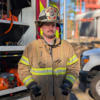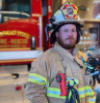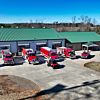

1 (336) 871-2334

5086 NC HWY 704 Sandy Ridge,NC.

Effective Through Teamwork

Welcome to the Official Website for the Northeast Stokes Fire & Rescue, Sandy Ridge, North Carolina
The firefighters proudly serve the citizens of the Northeast Stokes fire district











ALL CONTENT, INCLUDING ALL IMAGES AND PHOTOGRAPHY
EXCEPT AS SPECIFICALLY NOTED, IS PROPERTY OF
NORTHEAST STOKES VOLUNTEER FIRE & RESCUE.
CONTENT PROUDLY MAINTAINED BY A VOLUNTEER
Contact Information
To Contact Chief Clark, Click link below to Email. To contact ASST. Chief Webb, Click link below to Email. To Contact the Firehouse, Click link below to






Beach And Surf Safety
Like most people during the summer months...When the temperature rises, you’ll grab the kids, load the car and
head out for the beach. Just don’t forget to keep the safety of yourself and your loved ones in mind. While
the beach can be a great place to cool off this summer, it’s also important to respect the power of the ocean.
One of the leading causes of accidental death in the United States is drowning…killing nearly 5,000 people
each year. For children ages 1 to 2 years old, it’s usually the leading cause of death year after year.

Basic Beach Safety Tips:
Make sure lifeguards are on duty and ask about surf conditions before going in the water.
Try and swim in an area near a lifeguard tower and never swim alone. Only swim in designated areas.
Never dive in the surf head first. The water is not always clear and you may not notice any obstructions or
how shallow the water in front of you is.
Don’t swim out to far or overestimate your swimming ability. Never depend on flotation devices for your
safety. Swim parallel to the shore if you want to swim long distances.
Never drink alcohol and swim.
ALWAYS keep an eye on your children. Don’t turn away, even for a moment. Children can fall below the
surface in a second and it can be impossible to find them fast enough.
Always hold the hands of younger children. Sudden changes in surf direction can separate them
from you in an instant.
Swim parallel to the shore if you want to swim long distances.
Wear “Water Shoes” or sandals on the beach to avoid broken glass and sharp shells.
Lightning strikes at the beach are common in thunder storms. If you hear thunder, get out of the water
immediately. Seek shelter in a building or automobile. If no shelter is available, find the lowest spot possible
and avoid open spaces. Don't sit under an umbrella and stay away from metal objects like aluminum chairs.
If you get into trouble in the water, don't panic. Raise and wave your arm for help, float and wait for assistance.
Wear sunscreen, with at least a level 15 sun protection factor, to protect against burns.
Riptide Information:
What is a "Rip Tide"
Often mistakenly called undertows, these powerful currents pull even experienced swimmers away from
shore. Panic and drowning often result. The currents are formed when water rushes out to sea in a narrow path.
This happens when there is a break in a nearshore sandbar or the current is diverted by a groin, jetty or other
barrier. Rip currents can extend 1,000 feet offshore, reach 100 feet in width and travel up to 3 mph. Some
are present a few hours; others are permanent. Rip currents are more prevalent after storms.
Telltale signs of a riptide:
A difference in watercolor - either murkier from sediments or darker from greater depth.
A difference in the waves - larger, choppier waves in the rip current; smaller, calmer waves in front of the bar.
Foam or objects moving steadily seaward.
An offshore plume of turbid water past the sandbars. Polarized sunglasses cut glare and help to spot rip currents.
What To Do:
If you’re caught in a rip current, don’t panic or swim against the current. Swim parallel to shore until you are
out of the current. Rip currents are rarely more than 30 feet wide. If you can’t break out of the current, float
calmly until it dissipates, usually just beyond the breakers. Then swim diagonally to shore. If you don’t swim
well, stay in wading depths and watch for sudden drop-offs.

















Family Safety Tips:




Effective Through Teamwork
5086 NC HWY 704 Sandy Ridge,NC.

Welcome to the Official Website for the
Northeast Stokes Fire & Rescue, Sandy Ridge, NC
The firefighters proudly serve the
citizens of the Northeast Stokes fire district

1 (336) 871-2334







Contact Information
To Contact Chief Clark, Click link below to Email. To contact ASST. Chief Webb, Click link below to Email. To Contact the Firehouse, Click link below to Email.
ALL CONTENT, INCLUDING ALL IMAGES AND PHOTOGRAPHY
EXCEPT AS SPECIFICALLY NOTED, IS PROPERTY OF
NORTHEAST STOKES VOLUNTEER FIRE & RESCUE.
CONTENT PROUDLY MAINTAINED BY A VOLUNTEER







Beach And Surf Safety
Like most people during the summer
months...When the tempter rises,
you’ll grab the kids, load the car and
head out for the beach. Just don’t
forget to keep the safety of yourself
and your loved ones in mind. While
the beach can be a great place to
cool off this summer, it’s also
important to respect the power of
the ocean. One of the leading causes
of accidental death in the United
States is drowning…killing nearly
5,000 people each year. For children
ages 1 to 2 years old, it’s usually the
leading cause of death
year after year.

Make sure lifeguards are on duty
and ask about surf conditions
before going in the water.
Try and swim in an area near a
lifeguard tower and never swim
alone. Only swim in designated
areas.
Never dive in the surf head first.
The water is not always clear and
you may not notice any
obstructions or how shallow the
water in front of you is.
Don’t swim out to far or
overestimate your swimming
ability. Never depend on
flotation devices for your
safety. Swim parallel to the shore
if you want to swim long
distances.
Never drink alcohol and swim.
ALWAYS keep an eye on your
children. Don’t turn away, even
for a moment. Children can fall
below the surface in a second
and it can be impossible to find
them fast enough.
















Always hold the hands of younger children. Sudden
changes in surf direction can separate them
from you in an instant.
Swim parallel to the shore if you want to swim
long distances.
Wear “Water Shoes” or sandals on the beach to avoid
broken glass and sharp shells.
Lightning strikes at the beach are common in thunder
storms. If you hear thunder, get out of the water
immediately. Seek shelter in a building or automobile.
If no shelter is available, find the lowest spot possible
and avoid open spaces. Don't sit under an umbrella
and stay away from metal objects like aluminum
chairs.
If you get into trouble in the water, don't panic. Raise
and wave your arm for help, float and wait
for assistance.
Wear sunscreen, with at least a level 15 sun protection
factor, to protect against burns.
Riptide Information:
What is a "Rip Tide"
Often mistakenly called undertows, these powerful
currents pull even experienced swimmers away from
shore. Panic and drowning often result. The currents
are formed when water rushes out to sea in a narrow
path. This happens when there is a break in a
nearshore sandbar or the current is diverted by a groin,
jetty or other barrier. Rip currents can extend 1,000
feet offshore, reach 100 feet in width and travel up to
3 mph. Some are present a few hours; others are
permanent. Rip currents are more prevalent
after storms.
Telltale signs of a riptide:
A difference in watercolor - either murkier from
sediments or darker from greater depth.
A difference in the waves - larger, choppier waves in
the rip current; smaller, calmer waves in front of
the bar.
Foam or objects moving steadily seaward.
An offshore plume of turbid water past the sandbars.
Polarized sunglasses cut glare and help to spot
rip currents.
What To Do:
If you’re caught in a rip current, don’t panic or swim
against the current. Swim parallel to shore until you
are out of the current. Rip currents are rarely more
than 30 feet wide. If you can’t break out of the current,
float calmly until it dissipates, usually just beyond the
breakers. Then swim diagonally to shore. If you don’t
swim well, stay in wading depths and watch for
sudden drop-offs.
Basic Beach Safety Tips:

Family
Safety Tips:






























































































